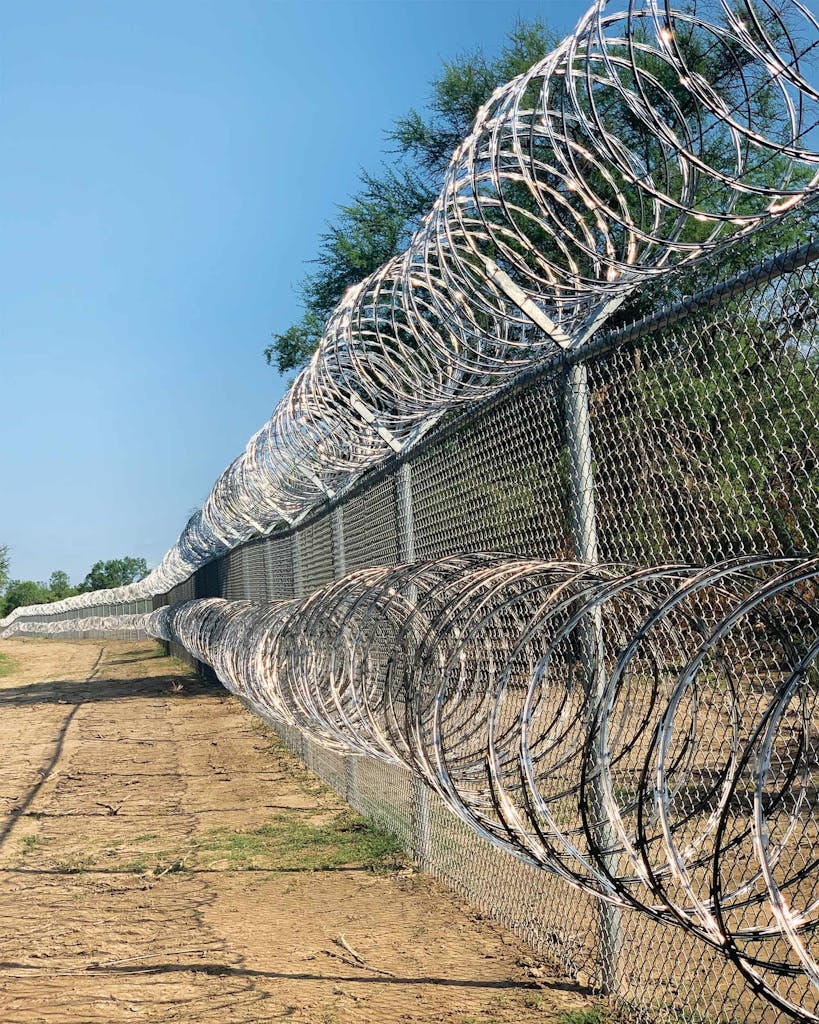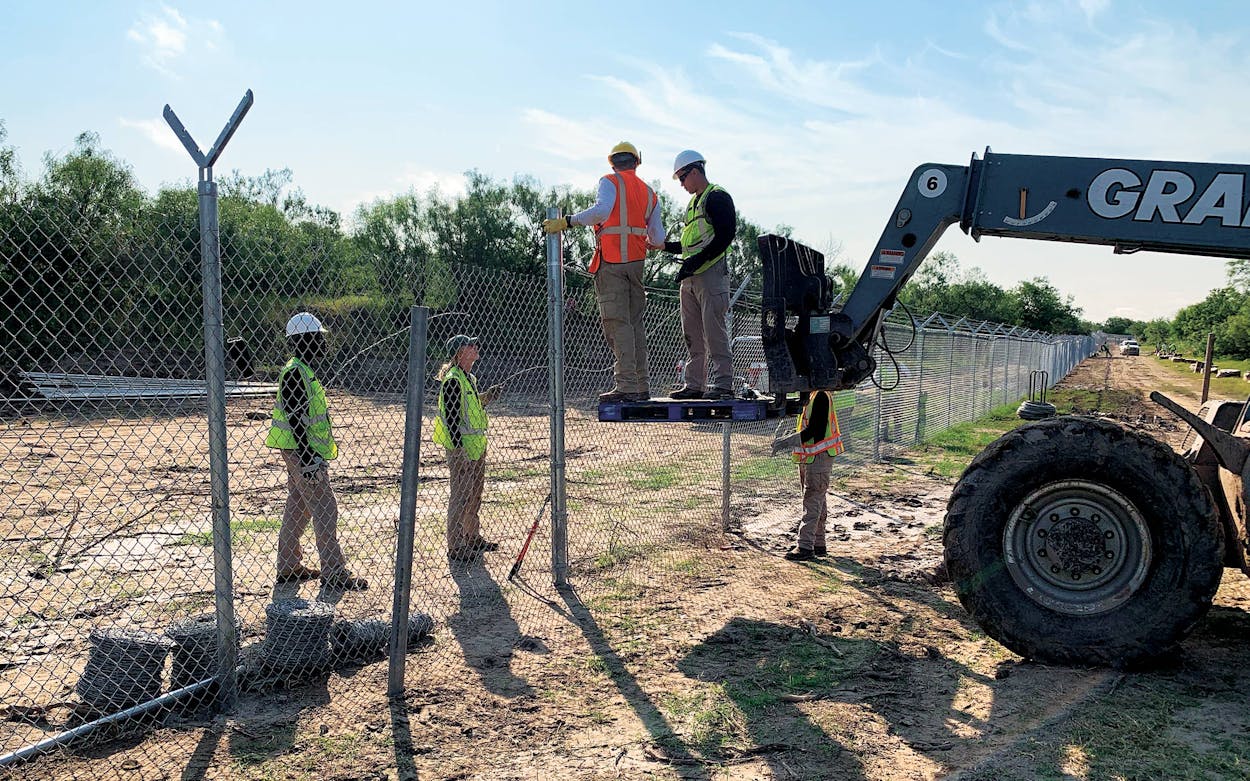Governor Greg Abbott’s border wall isn’t big or beautiful, like the one that President Trump promises. In fact, it isn’t even a wall. But bits of it are rising, after a fashion.
In recent weeks, 1.2 miles of chain-link fence has been erected on a spit of land, choked with carrizo cane, just west of Del Rio—part of the governor’s effort to finish the job Trump started and build a physical barrier along the Texas-Mexico border. The fence, roughly ten feet tall and a hundred feet from the Rio Grande, boasts rings of razor wire at chest level, with another complement of wire at the top. Its modest height, combined with the military-grade concertina wire, gives the effect of a Chihuahua sporting a large spiked collar.
The land that plays host to the fence, and where most of the immigrant arrests have taken place, is owned by Sergio Galindo, a prominent businessman in the area who provided materials for the nearby thirty-feet-high steel Trump wall. Galindo declined to be interviewed, but allowed Texas Monthly to tour his property several days after Abbott gave Fox News an “exclusive” revealing the project.
On a muggy late-July day, a group of Texas National Guardsmen, accompanied by rap music, hurriedly unfurled coils of razor wire as two of their number stood on the tines of a forklift to tinsel the top of the fence with the wire. Lewis Owens, the Democratic Val Verde county judge, was practically giddy as he described the endeavor. “They’re all excited,” Owens said of Galindo and other property owners who will soon be getting sections of fence. “They’re getting a brand-new fence, something that they’d never be able to afford, and with the presence of troopers from here and from Florida and from Nebraska.”
Abbott, who is running for reelection and pondering a bid for the White House in 2024, announced plans in June to build a Texas wall, after the Biden administration halted that most famous of Trump construction projects. “In the Biden Administration’s absence, Texas is stepping up to get the job done by building the border wall,” said Abbott. “We will secure the border, slow the influx of unlawful immigrants, and restore order in our border communities.”
In all, Texas has about 111 miles of completed barrier along its 1,241-mile border with Mexico, most of it authorized during the George W. Bush administration. It’s unclear where Abbott expects to find the $250 million he has pledged to spend on border barriers, but he’s asked the public to help foot the bill, a request that has raked in about $873,000 so far. He has also been tight-lipped about the wall’s exact locations, dribbling out details on Twitter and through Fox News, as he gears up for a tough reelection bid that involves five GOP challengers. “The state is providing some kind of effort to take control of the influx of migrants crossing and traversing through private land,” said Bruno “Ralphy” Lozano, the Democratic mayor of Del Rio. “The governor has taken initiative, and I completely support it.”
Last week, the state began filing state criminal charges, including for trespassing, against immigrants who illegally crossed the border from Mexico. In Val Verde County, the state has set up a tent outside the sheriff’s office to process immigrants before sending them to a state prison in Dilley. Val Verde County sheriff Joe Frank Martinez, a Democrat, told me that nearly all of the migrants arrested on state charges so far had been caught on Galindo’s property by Abbott’s fence.
Interviews with city, county, and state officials reveal a quickly evolving but opaque process that is being cobbled together on the fly by various state agencies, including the Texas Department of Public Safety, the Texas Department of Transportation, and the Texas Facilities Commission, which is in the process of hiring a project manager to oversee the initiative. Confusion is conspicuous at the local level, where officials like Owens are struggling to keep pace with the governor’s plans. “As soon as they get done with [Galindo], they’re going to jump across the street to start about three miles more,” Owens told me. “That was the plan, I mean, this stuff changes every thirty minutes or half a day or something.”
Already deployed as part of the governor’s Operation Lone Star initiative to secure the border, DPS troopers are seeking approval from landowners to build on their properties, and the Texas National Guard is providing much of the labor. George P. Bush, commissioner of the General Land Office, in June granted emergency authorization to build barriers on GLO-controlled state lands, mostly in far West Texas, and in early July the Texas Department of Transportation quickly awarded a $25 million contract to build a two-mile stretch of fence along a state right of way that parallels the border in downtown Eagle Pass.

On its eastern edge, the Galindo chain-link fence nearly meets up with a two-mile piece of black steel fencing completed during the Obama administration. On its western flank is Vega Verde Road and a few miles of riverfront properties owned by Galindo’s neighbors. Near the opposite bank, where the river is known as the Rio Bravo to Mexicans, families play in the water. In some areas the river is low enough to cross by foot, said Rob Jump, a sixty-year-old truck driver who owns an acre-and-a-half spread on the river. He’s painted the tops of his fence posts purple, he said, to warn off trespassers who cross from Mexico. The Border Patrol used to check in on Jump, but with as many as a thousand migrants crossing each day in recent months, he figures they’re now too busy. “Now we got Florida (state police) out here full time, and DPS,” Jump said. Recently the Val Verde sheriff’s department informed him that a fence is going up along Vega Verde, which will leave him and his neighbors between the fence and the river. “It’s unnerving,” Jump said. “I guess I’ll pay my taxes next year in Acuña”—the Mexican city just across the river.
Two weeks ago, I watched as heavy machinery cleared brush and moved earth on a strip of land between the international rail bridge and a pecan farm in downtown Eagle Pass. Brush had been pushed into dozens of tidy piles, making way for a fence scheduled to be completed by January 1, 2022, according to Anderson Columbia, which holds a $25 million contract to build the fence. From the time the emergency project was announced on the TxDOT website, it took only a week for it to be awarded. Anderson Columbia described its wall as a “safety barrier” consisting of a three-and-a-half-foot-tall concrete base, topped by fourteen-and-a-half-foot-tall steel bollards. A spokesperson with TxDOT said the areas targeted for wall construction are busy migrant corridors but provided no evidence to support the claim.
I drove along the denuded landscape with state representative Eddie Morales, a Democrat from Eagle Pass who previously served as an attorney for the city and fought legal battles against the federal government over the Bush and Trump walls. Morales opposes Abbott’s fence, arguing that there are more effective alternatives to slowing migration. But mostly Morales lamented the wasted opportunity. “I would much rather see that money invested into expanding our ports of entry,” Morales told me. “The governor would never lose again if he focused on enhancing business and trade at the border. That’s the one area he’s totally neglected.”
Some long-time opponents of border wall are also raising legal concerns. “They still have to comply with notice requirements, and environmental and preservation studies,” said Javier Peña, an Edinburg-based attorney. Peña explained that whether building on public or private land, all projects must go through the proper channels. “They can do whatever they want, but with the limitation that they can’t violate the law or U.S. treaty,” Peña said. Typically one of the biggest hurdles is getting approval from the International Boundary and Water Commission, or IBWC, the binational agency overseeing a treaty that requires the U.S. and Mexico to sign off on structures built in the floodplain. IBWC officials told Texas Monthly that it had not been contacted by the state about its border wall projects, but noted that an unspecified fence site near Del Rio was not on IBWC property.
Back in Val Verde County, conservative media, including Fox News and the Epoch Times, were set up at the Obama-era fence, across the street from a cement business owned by Galindo, where they were “waiting for illegals,” as a cameraman with Fox News informed me. Not far away, a group of immigrants—mostly families—rested in the shade of a mesquite tree and a tarp, as a pair of guardsmen kept watch over them. They waited near Abbott’s fence and they would soon find out if they would face state criminal charges.
- More About:
- Politics & Policy
- Border Wall
- Greg Abbott
- Eagle Pass
- Del Rio






